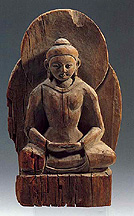
Found at the Peacock Cave, Kizil
7th century CE
Painted wood
Height: 13 cm
Acquisition number: #MIK III 7413
Image courtesy of the Museum für Indische Kunst (copyright reserved)
Staatliche Museen zu Berlin - Preussischer Kulturbesitz
The Peacock Cave was discovered during Albert Grünwedel 's third expedition to the Tarim Basin. The cave was filled to the ceiling with sand and debris, and it was not until the party had undertaken extensive excavation that the team discovered the wealth of religious material that lay buried under the sand. In his memoirs, Grünwedel describes his impressions at the time of the cave's discovery:
To the right and left of the door leading into the cella, strange antiquities were found… a high table with four legs with delicate ornamentation, and next to it a narrow small bench. Here a number of wooden idols were found. Also, on the opposite side, there were beautiful wooden Buddha figures, a small, greatly decayed stupa made of wood, etc.1
This sculpture was one of the images uncovered at this time in the Peacock Cave. It is carved rather roughly and left unfinished, though its makers may originally have expected it to be covered with a thin coat of gesso and colorfully painted. Though very different in scale, this image is closer in style similar to the Northern Wei-era colossal Buddha at Yungang than to contemporaneous Tang sculpture. This indicates a delay (perhaps willful) of at least a century in the adoption of the new sculptural styles practiced in China.
(1) Grünwedel, Albert. Altbuddhistiche Kultstätten in Chinesisch-Turkistan (Berlin, 1912), p. 87. Translated in Härtel, Herbert and Marianne Yaldiz, Along the Ancient Silk Routes: Central Asian Art from the West Berlin State Museums (New York: Metropolitan Museum of Art, 1982), p. 118.